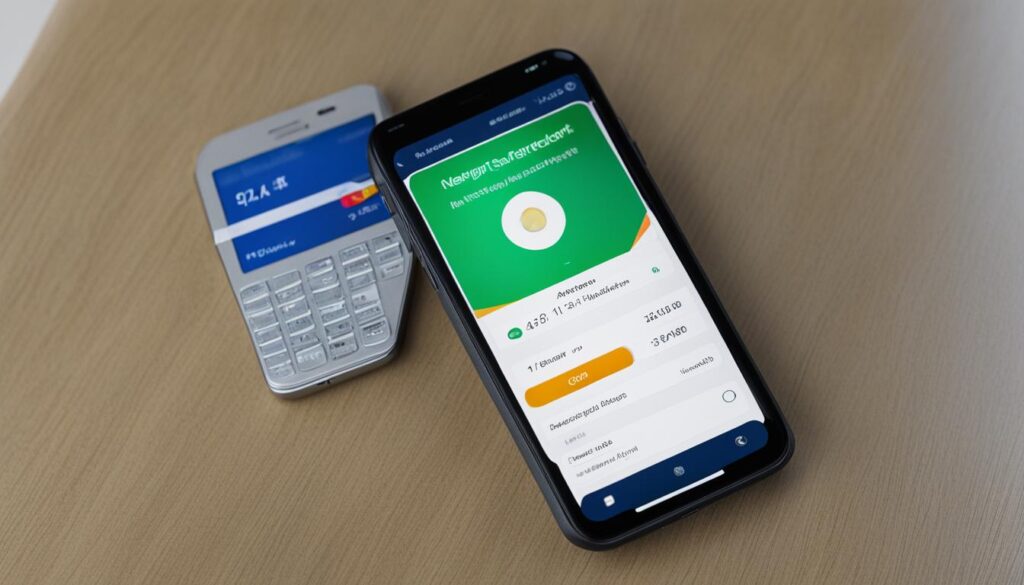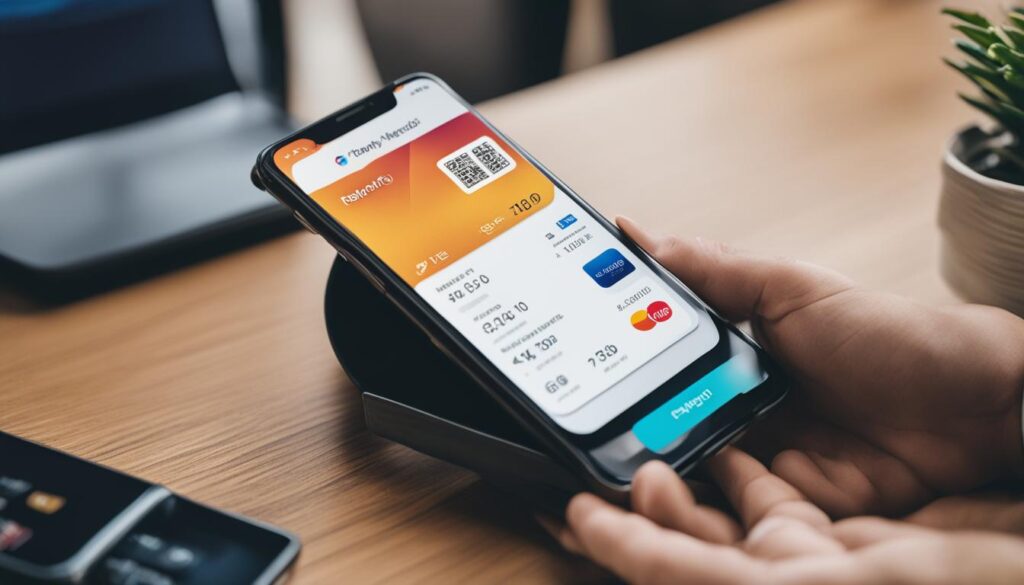Innovation in the financial services industry, particularly in mobile banking, is revolutionizing the way customers interact with their banks. To provide a great user experience, mobile banking applications prioritize simplicity, engagement, and contextual relevance. One key aspect of this is customizing secure banking alerts to meet the individual needs of customers.
Secure banking notifications ensure that customers stay informed about important updates and transactions. By tailoring these alerts to the preferences and requirements of each customer, banks can deliver a personalized and secure banking experience. Whether it’s receiving notifications for account activity, fraud detection, or banking updates, customized alerts play a crucial role in keeping customers informed and their finances secure.
Key Takeaways:
- Customizing secure banking alerts enhances the user experience
- Personalized alerts help keep customers informed and secure
- Secure banking notifications include fraud detection and account updates
- Mobile banking applications prioritize simplicity, engagement, and contextual relevance
- Stay informed and secure with customized secure banking alerts
Simplicity: Making Banking Easier for Customers
A great mobile banking application prioritizes simplicity to enhance the customer experience. By streamlining non-mobile processes, mobile banking apps make daily banking activities easier and more convenient. For example, the KeyRing app stores loyalty cards and links them to digital offers, eliminating the need for customers to carry physical cards. Similarly, the Marriott mobile app allows early check-ins and provides notifications about room availability and special offers, simplifying the hotel booking process.
Another example of simplicity in mobile banking is the OpenTable app, which suggests restaurants based on a user’s location. This eliminates the hassle of searching for nearby dining options and provides customers with quick and relevant recommendations. By focusing on simplicity, mobile banking apps remove unnecessary complexity from the banking experience, making it more user-friendly and efficient.
“Simplicity is the ultimate sophistication.” – Leonardo da Vinci
The Benefits of Simplicity in Mobile Banking
Simplicity in mobile banking offers several benefits to customers. First and foremost, it saves time and effort by reducing the number of steps required to complete banking tasks. With a simplified process, customers can easily perform tasks like transferring funds, paying bills, and managing their accounts on-the-go. This convenience is especially valuable in today’s fast-paced world where time is of the essence.
Furthermore, simplicity enhances the accessibility of mobile banking. By eliminating complex procedures and jargon, mobile banking becomes more inclusive and user-friendly for customers of all backgrounds and levels of technological proficiency. This broadens the reach of banking services and ensures that everyone can take advantage of the convenience and flexibility offered by mobile banking.
In conclusion, simplicity is a key factor in creating a successful mobile banking application. By focusing on making banking easier for customers through streamlined processes and intuitive features, mobile banking apps can provide a superior user experience. Simplicity saves time, enhances accessibility, and ultimately contributes to a positive customer experience in the world of mobile banking.
Engagement: Stimulating Positive Interaction
In today’s fast-paced world, mobile banking applications play a crucial role in delivering a positive customer experience. With the ever-increasing reliance on smartphones, it has become essential for mobile banking applications to engage users in a meaningful way. By providing features that go beyond the basic banking functionalities, these applications can stimulate positive interaction and enhance the overall user experience.
One of the key elements of customer engagement in mobile banking applications is offering more than just the traditional banking services. For example, the Marriott mobile application not only allows users to make reservations and check their loyalty balances, but it also offers additional features like early check-ins, notifications about room availability, and special offers. This level of engagement goes beyond the transactional aspects of banking and creates a connection between the user and the application.
Another important aspect of customer engagement is the ability of mobile banking applications to provide personalized notifications and recommendations. By leveraging data analytics and user preferences, these applications can deliver targeted content that is relevant to the user’s needs and interests. For instance, a mobile banking application can send notifications about exclusive offers or personalized financial tips based on the user’s spending patterns. This personalized approach not only enhances the user experience but also strengthens the overall engagement with the application.
Table: Features Promoting Engagement in Mobile Banking Applications
| Feature | Description |
|---|---|
| Personalized Notifications | Sending targeted alerts and recommendations based on user preferences and behaviors |
| Enhanced Functionalities | Providing additional features like early check-ins, room availability notifications, and special offers |
| Interactive Tools | Offering interactive financial calculators, budgeting tools, and educational resources |
| Social Integration | Enabling users to share their banking experiences, financial goals, and achievements on social media platforms |
In conclusion, customer engagement is a critical factor in the success of mobile banking applications. By going beyond basic banking functionalities and offering personalized experiences, these applications can stimulate positive interaction and foster a stronger connection with users. With the ever-evolving landscape of mobile technology, it is imperative for banks and financial institutions to prioritize customer engagement to stay competitive and meet the evolving needs of their customers.
Contextual: Providing Value Based on Location
Today’s mobile applications have the power to enhance the user experience by delivering personalized recommendations and valuable information based on the user’s location. With the rise of mobile banking, this contextual functionality has become a key feature in providing a tailored and convenient banking experience.
One example of a mobile app that leverages locational functionality is OpenTable. By using GPS technology, OpenTable suggests nearby restaurants based on the user’s current location. This not only saves time but also ensures that users are presented with relevant dining options. Additionally, the app takes into account the user’s previous dining experiences, further personalizing the recommendations.
Another app that offers locational functionality is GoBank. With a simple swipe of the finger, users can instantly check their account balance, making banking on-the-go effortless. This real-time information is invaluable for users who need to stay updated on their financial status while traveling or running errands.
| App | Description | Location-based Feature |
|---|---|---|
| OpenTable | A restaurant reservation and discovery app | Uses GPS to suggest nearby restaurants |
| GoBank | A mobile banking app | Provides instant balance information based on location |
By incorporating locational functionality, mobile banking apps can offer users a more personalized and relevant experience. Whether it’s finding a nearby ATM, receiving targeted promotions based on the user’s location, or providing real-time information, this contextual feature adds value and convenience to the overall mobile banking experience.
Contextual Personalization: Enhancing User Experience
Contextual personalization takes locational functionality a step further by analyzing user data and behavior to deliver even more tailored recommendations. For instance, a mobile banking app could suggest nearby merchants based on the user’s spending patterns or offer discounts at specific retailers when the user is physically close to their stores.
“Location-based recommendations in mobile banking provide users with relevant and timely information, enabling them to make better financial decisions on the go.”
This level of personalization not only enhances the user experience but also increases engagement and satisfaction with the mobile banking app. By providing real-time and location-specific recommendations, users feel more connected and supported in their financial journey.
As mobile banking continues to evolve, contextual personalization will play an increasingly important role in delivering value to users. By leveraging locational functionality and analyzing user data, mobile banking apps can provide personalized recommendations that truly enhance the overall banking experience.
Mobile Banking Features for a Best-in-class Relationship
Active mobile banking users expect a range of essential functionalities to be available in their mobile banking applications. These functionalities form the foundation of a best-in-class mobile banking relationship and contribute to a seamless digital banking experience. By embracing these features, banks can enhance the user experience, making banking more convenient and accessible.
One of the key features that users look for in a mobile banking application is mobile photo account opening. This functionality allows users to easily open new accounts by simply taking a photo of their identification documents. By streamlining the account opening process, banks can attract new customers and provide a frictionless onboarding experience.
Another crucial functionality is mobile bill pay. With this feature, users can conveniently pay their bills directly from their mobile devices, eliminating the need for manual payments or visits to physical banking branches. Mobile bill pay offers flexibility and convenience, allowing users to manage their finances on the go.
In addition to mobile bill pay, mobile deposits are also highly valued by mobile banking users. This feature enables users to deposit checks using their mobile phones, eliminating the need to visit a physical branch or ATM. Mobile deposits save time and offer added convenience, allowing users to manage their funds efficiently.
Last but not least, mobile balance transfers are an essential functionality for many mobile banking users. With this feature, users can easily transfer funds between their different accounts, making it convenient to manage their finances and allocate funds where needed.
By offering these key functionalities, mobile banking applications can provide a best-in-class digital banking experience. Users can enjoy the convenience and flexibility of mobile photo account opening, mobile bill pay, mobile deposits, and mobile balance transfers, all from the palm of their hand. These features empower users to take control of their finances and enhance their overall banking relationship.

The Importance of Payments in Mobile Banking
Payments play a crucial role in mobile banking, and mobile payment applications are constantly evolving. The ability to make secure and convenient payments is a key feature that users expect from their mobile banking experience. With the advancement of technology, mobile payments have become more accessible and diverse, offering multiple methods for users to transfer funds and make purchases.
One example of a mobile payment application is Commonwealth Bank’s CommBank Kaching. This application allows users to make peer-to-peer payments through various methods such as bumping phones, using mobile phone numbers or email addresses, and even QR codes. These innovative payment options provide users with flexibility and convenience, allowing them to easily transfer funds to friends, family, or businesses.
Another important feature in payment applications is the ability to provide real-time transaction insights and mobile receipt capabilities. This allows users to track their spending and have a clear overview of their financial transactions. With real-time updates, users can stay informed about their account activities, ensuring transparency and security.
When it comes to mobile banking, payment applications are an integral part of the overall banking experience. They offer users the convenience of making payments anytime, anywhere, and provide added security measures to protect against fraud. As technology continues to advance, mobile payment applications will undoubtedly continue to enhance the mobile banking experience, making it easier and more efficient for users to manage their finances.

Table: Comparison of Mobile Payment Applications
| Payment Application | Features | Supported Payment Methods |
|---|---|---|
| CommBank Kaching | – Peer-to-peer payments – Real-time transaction insights – Mobile receipt capabilities | – Bumping phones – Mobile phone numbers or email addresses – QR codes |
| Google Pay | – Contactless payments – In-app purchases – Loyalty card integration | – NFC technology – linked cards or bank accounts – Loyalty program integration |
| Apple Pay | – Touchless payments – In-app purchases – Rewards and discounts | – NFC technology – linked cards or bank accounts – Apple Cash |
Enhancing Engagement with Personalized Content
Personalization is becoming increasingly important in mobile banking. By segmenting subscribers based on their interests, mobile banking applications can send personalized content recommendations. This can include offers, sales, and relevant information based on the subscriber’s browsing history or previous interactions with the app.
Subscriber segmentation allows mobile banking apps to deliver targeted content that resonates with individual users. By understanding their preferences, habits, and needs, banks can create a more engaging and tailored experience. For example, a user who frequently browses travel-related features can receive personalized recommendations for travel deals and promotions.
With personalized content recommendations, mobile banking apps can foster deeper customer engagement. By delivering content that is relevant and valuable to each user, banks can enhance customer satisfaction and loyalty. Subscribers are more likely to stay engaged with an app that understands their needs and provides personalized solutions.
Furthermore, personalized content recommendations can also drive additional revenue streams for banks. By tailoring offers and promotions based on user segments, banks can increase cross-selling and upselling opportunities. This targeted approach allows banks to maximize their marketing efforts and generate a higher return on investment.
Benefits of Personalized Content Recommendations
- Improved customer engagement
- Enhanced user experience and satisfaction
- Increased potential for cross-selling and upselling
- Higher ROI on marketing campaigns
In conclusion, personalized content recommendations based on subscriber segmentation are a powerful tool for mobile banking apps. By delivering tailored content, banks can enhance engagement, provide a more satisfying user experience, and drive additional revenue. As mobile banking continues to evolve, personalization will play an increasingly important role in meeting the needs and expectations of individual customers.
Conclusion
Customizing secure banking alerts is crucial for ensuring a personalized and secure banking experience. To provide an excellent user experience, mobile banking applications should prioritize simplicity, engagement, and contextual relevance. By integrating features such as mobile photo account opening, mobile deposits, and personalized content recommendations, mobile banking can be tailored to meet the unique needs of individual customers.
One key aspect of enhancing security in mobile banking is through customized alerts. Secure banking notifications enable users to stay informed about their account activities, ensuring they are promptly alerted to any suspicious or fraudulent transactions. By receiving real-time alerts, individuals can take immediate action to protect their finances and mitigate potential risks.
Furthermore, fraud detection is a crucial element of secure banking. By leveraging advanced technologies and algorithms, mobile banking applications can detect and prevent fraudulent activities, safeguarding customers’ accounts and providing peace of mind. Customized alerts play a significant role in this process, offering an additional layer of protection by notifying users of any suspicious activities that may require their attention.
In summary, maintaining the security of mobile banking is essential in today’s digital landscape. By incorporating customized alerts, fraud detection, and secure banking notifications, financial institutions can ensure that their customers have a personalized and secure banking experience. Stay informed, stay protected, and enjoy the convenience of mobile banking.
FAQ
What are secure banking notifications?
Secure banking notifications are alerts sent to customers to keep them informed about their banking activities and help detect any potential fraud.
How can I customize secure banking alerts?
You can customize secure banking alerts by choosing which types of notifications you want to receive and setting preferences for the frequency and method of delivery.
What updates will I receive through secure banking notifications?
Secure banking notifications may include updates on account balances, transaction alerts, payment due dates, suspicious activity detection, and other important banking information.
How can a mobile banking application make banking easier for customers?
A mobile banking application can simplify non-mobile processes, such as account opening, bill payments, deposits, and balance transfers, making banking more convenient and efficient for customers.
How can a mobile banking application stimulate positive interaction?
A mobile banking application can engage customers by offering features beyond basic banking functions, such as early check-ins, notifications about special offers, and personalized recommendations based on their preferences and previous interactions.
How can a mobile banking application provide value based on location?
A mobile banking application can utilize locational functionality to suggest nearby services, such as restaurants or ATMs, based on the user’s current location. This enhances the user experience and provides personalized recommendations.
What are the key features for a best-in-class mobile banking relationship?
The key features include mobile photo account opening, mobile bill pay, mobile deposits, and mobile balance transfers. These functionalities simplify banking processes and make it more convenient for users.
What role do payments play in mobile banking?
Payments are crucial in mobile banking, and mobile payment applications are constantly evolving. They enable P2P payments, provide real-time transaction insights, and often offer various methods of payment, such as bumping phones, using mobile phone numbers or email addresses, and QR codes.
How can mobile banking applications enhance engagement with personalized content?
Mobile banking applications can segment subscribers based on their interests and send personalized content recommendations, including offers, sales, and relevant information based on the subscriber’s browsing history or previous interactions with the app.
How do customized secure banking alerts contribute to a secure banking experience?
By customizing secure banking alerts, customers can receive timely notifications about their banking activities, which helps them stay informed and detect any potential fraudulent transactions, enhancing the overall security of their banking experience.
How Can I Customize Mobile Banking Alerts to Ensure Security?
Setting up mobile banking alerts wisely is crucial for ensuring security. By customizing these alerts, users can receive real-time notifications about their account activities, such as large transactions or unusual login attempts. This enables immediate action to be taken in case of suspicious activities, enhancing the overall safety of mobile banking transactions.


Pingback: Statement Scrutiny: How to Review Bank Statements for Security Breaches – Straight Fire Money